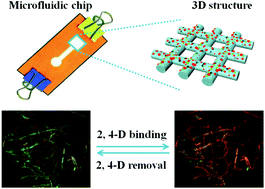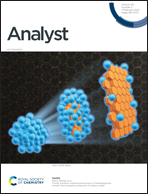Fluorescence detection of 2,4-dichlorophenoxyacetic acid by ratiometric fluorescence imaging on paper-based microfluidic chips†
Abstract
Fluorescence detection of pesticide contamination enables timely control of food safety. This study aims to construct novel and facile microfluidic paper-based analytical devices for the ratiometric fluorescence determination of pesticides. Through fluorescence resonance energy transfer (FRET) of nitrobenzoxadiazole (NBD) and CdTe quantum dots (QDs), the new microfluidic paper chips allowed the rapid and selective visual detection of 2,4-dichlorophenoxyacetic acid (2,4-D). The performance changes of the fluorescent material on solid matrix material were studied in detail. The sensor products exhibited visual observability and fluorescence characteristics. Under optimized conditions, the sensors showed satisfactory linearity in the range of 0.56–80 μM, and achieved detection limits as low as 90 nM. The sensors were successfully applied for soybean sprouts and lake water samples. Four levels of spiked-in 2,4-D concentrations were obtained with high recovery rates ranging from 86.2% to 109.5% and the RSD less than 4.19%. Thus, the present work described the integration of surface imprinted grafts on cellulose paper and ratiometric fluorescence techniques for highly sensitive separation and detection of pesticides in real food and environmental samples. Ultimately, this study paved the way for the development of novel ratiometric fluorescence detection to address food safety and environmental issues.



 Please wait while we load your content...
Please wait while we load your content...